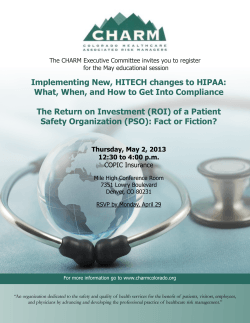
Return on Investment - The Business Value Manager
P.O. BOX 655 SHARON, PA 16146 (724) 346-0150 Advice for business Advice owners, for business investors and owners, service providers investors and on how to build service providers value and wealth on how to build through value and wealth investment in through closely held investment companies.in closely held companies. Executive Summary—Page 2 Executive Summary—Page 2 VA LUAT ION A DV IS OR Y S ER V IC ES The Business Value Manager Return on Investment Critical Metrics Owners and Board Members Must Understand (For a longer, more technical version of this discussion, including an illustration, visit our website at: www.evansandassociates.com) Most private company owners are uniquely uninformed or even misinformed about their return on investment (ROI). As a result, they frequently make poor investment choices, take unnecessary risks and fail to build long-term private company wealth. Many ROI-related mistakes—ranging from operating decisions to making investments or acquisitions– can be avoided through a basic understanding of the unique ROI mechanics of a private company. This edition of The Business Value Manager is a primer on how to measure and manage private company ROI. vested. Those past amounts are irrelevant for an investment decision today. For sound ROI decisions, use your company’s current value as your investment. This is the greater of the fair market value of your net operating assets or the present value of the cash flows your business expects to generate in the future. Both can and should be calculated annually to enable you to monitor how the value of your investment is changing over time. If the value of your net operating assets exceeds the “Many ROI-related mistakes– present To successfully measure and monitor your ranging from operating value of return on investment to build private comdecisions to making your future pany wealth, you must employ the correct investments or acquisitions– cash flows, measures of these four key ROI metrics: your operacan be avoided through a basic tions are not 1. Investment understanding of the unique adequately 2. Return ROI mechanics of a private profitable. 3. Rate of Return company.” This means 4. Value that even if your company possesses favorable goodwill characteristics, such as repuInvestment Owners instinctively think that the capital they tation, technology and customers, it lacks have tied up in their company is either the ex- goodwill value if it fails to convert these ternal funds they invested in it, or that total plus characteristics into adequate profits. When (Continued on page 2) the company’s profits that have been rein- PAGE 2 (Continued from page 1) this occurs, you must make changes to build value in your private company. These changes, which are discussed in more detail in the online version of this article, require you to achieve one or more of the following: ♦ Decrease in the assets used by the business ♦ Increase in the net cash flow created by the business ♦ Decrease in the company’s risk Any combination of these changes creates cash for owners or improves their likelihood of creating cash in the future, and these increase private company value. Return Owners instinctively think of some level of their company’s profit as their return on their investment, and this is almost never correct. The investor’s true return is the cash (not income) that can be taken out of the business without hurting it. This return is called net cash flow to invested capital, and it is what is left for capital providers after the company has paid all of its expenses and income taxes, and has made required investments in both working capital and fixed assets to keep the business competitive. This measure of return appears nowhere on your company’s financial statements, so it has to be computed for you. Note that this net cash flow is before interest expense is conNet Cash Flow to Invested Capital Net Income After Taxes Add: Interest expense, net of income tax Add: Noncash charges—depreciation and amortization Less: Capital expenditures Less: Working capital needs = Net Cash Flow to Invested Capital sidered. Return is calculated this way because owners can improve their ROI by effective use of lower cost debt. Private company owners should monitor their debt capacity, and annually evaluate how prudent use of debt could improve their ROI. The online version of this article calculates and illustrates how debt can be used to increase ROI for private company investors. Owners should also recognize that the company’s net cash flow return drives appreciation in stock value. The higher the company’s cash flow returns, the more buyers will pay to own that stock. This is the same process that drives public company stock values. Rate of Return Rate of return reflects risk, which is the likelihood that the business will achieve its forecasted returns. Future cash flows that are more likely to occur carry lower risk and generate higher value. Conversely, future cash flows that are harder to achieve are less certain, and this increased risk decreases value. The level of risk in a company is affected by the quality of a company’s management, its customer base and other factors that reflect its ability to compete in the market. The level of investment risk can be quantified by applying a rate of return (also called a discount rate or a cost of capital) to forecasted future cash flows to compute their present value. This calculation that discounts a forecast is detailed, but it generates more reliable value estimates. Risk can also be estimated by applying a multiple to a measure of return. For example, you may hear that a company is worth “five times EBITDA,” which suggests companies of that level of risk sell at a multiple of five times their earnings before interest, taxes, depreciation and amortization (EBITDA). This procedure for estimating risk and computing value—though simple—is far less reliable. Rather than developing a multiple year forecast of the capital providers’ real net cash flow returns, it looks at a less precise measure of EXECUTIVE SUMMARY When private company owners and executives understand the proper way to calculate ROI– using numbers not shown on traditional financial statements– they greatly enhance their likelihood to achieve an adequate ROI for their business. The critical mechanics are investment, return, rate of return and value. This issue of The Business Value Manager is a primer on how to use them correctly. (Continued on page 3) PAGE 3 to sell your stock today, by default you are electing to “Wise investors never lose sight of invest in your stock at its curthe fact that an alternative to rent value. Whether or not continued ownership of their this is a wise decision depends on your company’s private company is sale of it to a future profitability, growth strategic buyer who can create prospects and risk. If these synergies and value value drivers are adequately enhancement.” favorable, your decision to continue to own the stock The message here should be clear: Risk must be accumakes sense. With poor prospects and greater risk, the better rately quantified for sound ROI decisions and value conclusions, and the benefits of use of a rate of return and a forecast choice is to sell at an appropriate price and invest the proceeds in an alternative that offers a better ROI. justify the additional effort they require. Value Based on the prior discussion, it should be clear that the Conclusion Your private company should be more to you than just a job or where you work. It is an investment—perhaps your largest investment—which requires sound ROI decisions. How much should your annual net cash flow be? (Continued from page 2) the company’s return for only one year. This fails to consider different possible growth prospects. And if that one year, usually the last or next fiscal year, is unusually strong or weak, performance and value will be distorted. Finally, consider why the multiple was five times earnings, rather than four or six times or something else. There is seldom a thorough explanation offered for this difference, but its effect and ROI and value can be huge. Probably at least 15% of the current fair market value of your net operating assets. If it is below this, your operations are not adequately profitable, and your operations will not create value for you. The 15% rate would be lower for larger, stronger companies and would be higher for smaller, more risky ones. value of your business is the greater of the current value of your net operating assets—if your operations fail to create value—or the present value of your future net cash flows. This value also is your investment in your company for ROI purposes. Investors should understand that their company may have a higher strategic value—perhaps significantly higher—to a strategic investor who, in buying the company, could create higher returns, a lower capital investment, or lower risks through their acquisition and ownership. Wise investors never lose sight of the fact that an alternative to continued ownership of their private company is sale of it to a strategic buyer who can create synergies and value enhancement and that through a sale, the seller often can share in these synergistic benefits. Think of your investment decision this way: By choosing not If you seriously want to build long-term value in your private company, call us to learn how to implement this process. With a well formulated plan and process, your company can produce a much improved ROI. EDITOR’S NOTE: You or your CFO can review a longer, more technical version of this discussion, including an illustration, by visiting our website at www.evansandassociates.net Index of Recent Issues of THE BUSINESS VALUE MANAGER “Is Your Company Building Wealth—12 Value Metrics” “Is Your Shareholder Agreement a Timebomb?” “Transfer Wealth at Discounted Values” “SPECIAL REPORT: Sarbanes Oxley” “Protecting Your Private Company Wealth from the Government” “Critical Challenges Every Private Company Owner Must Address” “Exit Planning: Recognize When Your Ability To Compete Is Declining” To order back copies, please contact us at smyers@evansandassociates.net Reproduction is prohibited without permission. P.O. Box 655 One East State Street Sharon, PA 16146 Phone: 724-346-0150 Fax: 724-342-4510 Visit us on the Web! www.evansandassociates.net Frank C. Evans ASA, CBA, CPA/ABV fevans@evansandassociates.net Our Mission Evans and Associates is a leading provider of strategic valuation advisory services. We maximize wealth and profits for individuals and corporations. When your circumstances require measurement or management of business value, our focused approach provides solutions. Our team’s expertise in competitive analysis, finance and accounting, merger and acquisition, risk analysis and value creation forms the basis for our opinions and advice. Typical engagements for Evans and Associates include specialized valuation consultation for the purpose of gift or estate planning, merger and acquisition, shareholder value enhancement and litigation support. Evans and Associates Partner Credentials Include: Accredited Senior Appraiser Certified Business Appraiser Certified Public Accountant Accredited in Business Valuation Personal Attention Backed by a Network of National Resources Personal Attention Backed by a Evans and Associates is a specialized valuation advisory firm Network ofprovide National Resources small enough to the personal attention you want, but deep enough to possess the broad range of service expertise Smith Evans Carrier a specialized advisory firm you may need. Ourismembership invaluation the American Business small enough to provide the personal attention you want, but Appraisers (ABA) national network– we were the founding deep enough to possess the broad range of service expertise affiliate member—provides resources and advice from other you may need. Our valuation membership in the Our American Business nationally known experts. ABA affiliation Appraisers (ABA) national network– we were the founding enables us to effectively execute virtually any valuation or affiliate member– provides resources and advice from other merger and acquisition assignment. nationally known valuation experts. Our ABA affiliation enables us to effectively execute virtually any valuation or merger and acquisition assignment.
© Copyright 2025





















